Kenneth C. Davis's Blog, page 65
August 6, 2016
August 6-“Hiroshima Day”

The Atomic Bomb Dome-Hiroshima (Photo Courtesy of Hiroshima and Nagasaki Remembered)
On August 6, 1945, the New York Times asked:
“What is this terrible new weapon?”
(Source, New York Times, August 6, 1945: “First Atomic Bomb Dropped on Japan”)
The story followed the announcement made by President Truman:
“SIXTEEN HOURS AGO an American airplane dropped one bomb on Hiroshima, an important Japanese Army base. That bomb had more power than 20,000 tons of T.N.T. It had more than two thousand times the blast power of the British “Grand Slam” which is the largest bomb ever yet used in the history of warfare.”
August 6, 1945
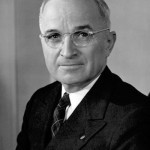
President Harry S. Truman
(Photo: Truman Library)
(“Statement by the President Announcing the Use of the A-Bomb at Hiroshima”: Truman Library and Museum)
The first atomic bomb was exploded in a test at Alamogordo, New Mexico, on July 16, 1945. President Truman, who had taken office upon the death of President Roosevelt on April 12 without knowledge of the Manhattan Project or the atomic bomb’s existence, was alerted to the success of this test at a meeting with Churchill and Stalin at Potsdam, a city in defeated Germany. (See this recent post on Potsdam)
The atomic bomb was detonated over Hiroshima on August 6, 1945. A second device, a plutonium bomb, was used on the city of Nagasaki on August 9. Japan surrendered on August 14.
Almost since the day the first bomb was dropped on Hiroshima, critics have second-guessed Truman’s decision and motives. A generation of historians have defended or repudiated the need for unleashing the atomic weapon.
What history has confirmed is that the men who made the bomb really didn’t understand how horrifying its capabilities were. Of course, they understood the destructive power of the bomb, but radiation’s dangers were far less understood. As author Peter Wyden tells it in Day One, an account of the making and dropping of the bomb, scientists involved in creating what they called “the gadget” believed that anyone who might be killed by radiation would die from falling bricks first.
In less than one second, the fireball had expanded to 900 feet. The blast wave shattered windows for a distance of ten miles and was felt as far away as 37 miles. Over two-thirds of Hiroshima’s buildings were demolished. The hundreds of fires, ignited by the thermal pulse, combined to produce a firestorm that had incinerated everything within about 4.4 miles of ground zero.
The estimated death toll was eighty thousand people killed instantly in Hiroshima; as many as 90 percent of the city’s nurses and doctors also died instantly. (By 1950, as many as 200,000 had died as a result of long-term effects of radiation.) The death toll in Nagasaki also reached 80,000 by the end of 1945.
Today should not be a day to argue about the politics of the bomb. It should be a day of solemn remembrance of these victims. And of contemplating the horrific power of the weapons we create.
The City of Hiroshima Peace Memorial Park and Museum offers an English language website with a history of Hiroshima and the effects of the bombing.
You can read more about Hiroshima and the dropping of the atomic bombs in Don’t Know Much About History and more about President Truman in Don’t Know Much About the American Presidents and in The Hidden History of America At War.

Don’t Know Much About History (Revised, Expanded and Updated Edition)
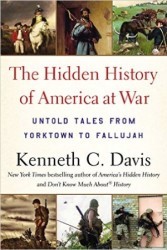
Now In paperback THE HIDDEN HISTORY OF AMERICA AT WAR: Untold Tales from Yorktown to Fallujah
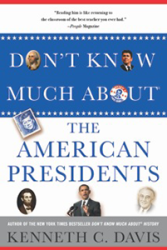
Don’t Know Much About® the American Presidents (Hyperion paperback-April 15, 2014)
July 26, 2016
Don’t Know Much About Executive Order 9981
[Repost; originally posted 7/26/2013]
On July 26, 1948, President Harry S. Truman issued an Executive Order that ended official discrimination in the United States military.
[image error]
After Truman’s order. the U.S. military was desegregated and integrated units fought in Korea. (Photo: U.S. Army-November 1950)
It is hereby declared to be the policy of the President that there shall be equality of treatment and opportunity for all persons in the armed services without regard to race, color, religion or national origin. This policy shall be put into effect as rapidly as possible, having due regard to the time required to effectuate any necessary changes without impairing efficiency or morale.
Coming in an election year, it was a daring move by Truman, who still needed the support of southern segregationists. It was also a controversial decision that led to the forced retirement of the Secretary of the Army when he refused to desegregate the Army.
As historical documents go, “Executive Order 9981” doesn’t have quite the same ring as “Emancipation Proclamation” or “New Deal.” But when President Harry S. Truman issued this Executive Order, he helped transform the country. This order began the gradual official process of desegregating America’s armed forces, which was a groundbreaking step for the American civil rights movement. (It is worth noting that many of the arguments made at the time against integration of the armed services –unit cohesion, morale of the troops, discipline in the ranks– were also made about the question of homosexuals serving in the military, a policy effectively ended when “Don’t Ask, Don’t Tell” was overturned in 2011.)
In a Defense Department history of the integration of the Armed Forces, Brigadier General James Collins Jr. wrote in 1980:
The integration of the armed forces was a momentous event in our military and national history…. The experiences in World War II and the postwar pressures generated by the civil rights movement compelled all the services –Army, Navy, Air Force, and Marine Corps — to reexamine their traditional practices of segregation. While there were differences in the ways that the services moved toward integration, all were subject to the same demands, fears, and prejudices and had the same need to use their resources in a more rational and economical way. All of them reached the same conclusion: traditional attitudes toward minorities must give way to democratic concepts of civil rights.
Here is the text of the Executive Order 9981 (dated July 26, 1948)
A Chronology of events leading to the Order and more information can be found at the the Truman Library.
You can learn more about Truman in Don’t Know Much About® the American Presidents and more about the Cold War and Korean War in Don’t Know Much About® History.

Don’t Know Much About® the American Presidents (Hyperion Paperback-April 15, 2014)
A First Lady on Who Built the White House
On the opening night of the Democratic National Convention, First Lady Michelle Obama had the audience riveted with her speech.
“I wake up every morning in a house that was built by slaves, and I watch my daughters, two beautiful, intelligent black young women, playing with their dogs on the White House lawn,” she said. “And because of Hillary Clinton, my daughters and all of our sons and daughters now take for granted that a woman can be president of the United States.”

First Lady Michelle Obama (Photo Credit: Sam Hodgson for The New York Times)
But Michelle Obama is not the first FLOTUS to remark on who built the White House. In 1800, shortly after arriving in Washington to take up residence in the unfinished President’s House, Abigail Adams wrote to her uncle, Cotton Tufts, about the construction of the capital city and the new executive palace:
The effects of Slavery are visible every where; and I have amused myself from day to day in looking at the labour of 12 negroes from my window, who are employd with four small Horse Carts to remove some dirt in front of the house. the four carts are all loaded at the same time, and whilst four carry this rubish about half a mile, the remaining eight rest upon their Shovels, Two of our hardy N England men would do as much work in a day as the whole 12, but it is true Republicanism that drive the Slaves half fed, and destitute of clothing…whilst the owner waches about Idle, tho his one Slave is all the property he can boast, Such is the case of many of the inhabitants of this place.
—Abigail Smith Adams to Cotton Tufts, 28 November 1800 (Source: National Archives)
Mrs. Adams found slavery morally distasteful and woefully inefficient. Although her husband, John Adams, had never enslaved any people, Abigail Smith Adams had grown up in a slaveholding household. She later became an outspoken opponent of slavery.
After the White House burned in 1815, it was rebuilt, again using enslaved labor. Read more about the history of slavery and the early presidency in the forthcoming In the Shadow of Liberty: The Hidden History of Slavery, Four Presidents, and Five Black Lives (September 20, 2016)

In the Shadow of Liberty: The Hidden History of Slavery, Four Presidents, and Five Black Lives (Holt Books & Random House Penguin Audio-Sept. 2016)
July 11, 2016
“Two Societies, One Black, One White”
(Revised post originally published on February 29, 2016)
Nearly 50 years ago, on July 28, 1967, President Lyndon B. Johnson established an 11-member National Advisory Commission on Civil Disorders. He was responding to a series of violent outbursts in predominantly black urban neighborhoods in such cities as Detroit and Newark. (New York Times account.)

Time Magazine cover August 4, 1967
On Feb. 29, 1968, President Johnson’s National Advisory Commission on Civil Disorders, later known as the Kerner Commission after its chairman, Governor Otto Kerner, Jr. of Illinois, issued a stark warning:
“Our Nation Is Moving Toward Two Societies, One Black, One White—Separate and Unequal”
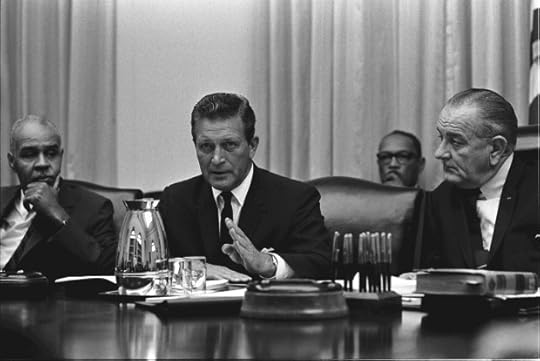
Governor of Illinois Otto Kerner, Jr., meeting with Roy Wilkins (left) and President Lyndon Johnson (right) in the White House. 29 July 1967 Source LBJ Presidential Library
The Committee Report went on to identify a set of “deeply held grievances” that it believed had led to the violence.
Although almost all cities had some sort of formal grievance mechanism for handling citizen complaints, this typically was regarded by Negroes as ineffective and was generally ignored.
Although specific grievances varied from city to city, at least 12 deeply held grievances can be identified and ranked into three levels of relative intensity:
First Level of Intensity
1. Police practices
2. Unemployment and underemployment
3. Inadequate housing
Second Level of Intensity
4. Inadequate education
5. Poor recreation facilities and programs
6. Ineffectiveness of the political structure and grievance mechanisms.
Third Level of Intensity
7. Disrespectful white attitudes
8. Discriminatory administration of justice
9. Inadequacy of federal programs
10. Inadequacy of municipal services
11. Discriminatory consumer and credit practices
12. Inadequate welfare programs
Source: “Our Nation is Moving Toward Two Societies, One Black, One White—Separate and Unequal”: Excerpts from the Kerner Report; American Social History Project / Center for Media and Learning (Graduate Center, CUNY)
and the Roy Rosenzweig Center for History and New Media (George Mason University).
Issued nearly half a century ago, the list of grievances reads as if it could have been written last week.
July 10, 2016
“Top 10 Political Conventions that Mattered Most”
Most of the drama is already gone from both parties’ presidential nominating conventions. That could change. But here’s a quick history of some of the most dramatic and important political conventions of the past.

Meeting of the Southern seceders from the Democratic Convention at St. Andrew’s Hall, Charleston, South Carolina, April 30, 1860. Illus. in: Harper’s Weekly, (1860 May 12). (Library of Congress)
National conventions, once riveting political theater that held America in suspense for days, have been reduced to a made-for-television, political promo for the two parties. Since primary elections now routinely determine the candidates, this quadrennial dog-and-pony show offers a ho-hum pageant, in which windy speeches are delivered, party platforms hammered out and often ignored, and delegates don silly hats and hold up handmade signs extolling the virtues of candidates, causes and home states. Once the scene of bare-knuckle politicking and backroom deals, the modern conventions now provide comforting tableaus –full of sound and fury, but mostly signifying nothing.
–The Top 10 Political Conventions That Mattered Most
Excerpted from this 2012 article at Smithsonian.com
July 1, 2016
Whatever Became of 56 Signers? (11 of 11)
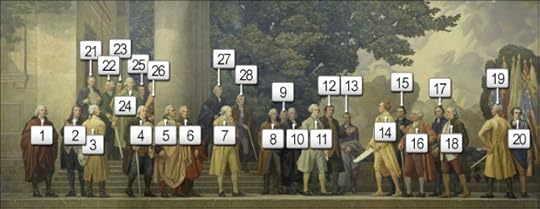
The Declaration Mural by Barry Faukner (National Archives)
Last part of a series on the lives of the 56 men who signed the Declaration of Independence, adopted by the Second Continental Congress on July 4, 1776. (A YES following the entry means the signer owned slaves; a NO means he did not own slaves.)
…We mutually pledge to each other our Lives, our Fortunes , and our Sacred Honor.
A New England slaver. A forgotten founder who died in debt and disgrace. A college president. A legendary bullet maker. Jefferson’s teacher –and a murder victim. Last but not least among the 56 signers.
–William Whipple (New Hampshire) Usually described as a 46 year old merchant, he was more precisely a sea captain who made a fortune sailing between Africa and the West Indies — in other words, the slave trade. He also owned slaves and one of those people, known as Prince, accompanied Whipple throughout his illustrious career as an officer in the Revolution. It was thought that Prince was the black man depicted in the famous “Washington Crossing the Delaware” painting, but that is not accurate because Prince and Whipple were far from the action that night. Whipple later served in a variety of state offices in New Hampshire and legally manumitted Prince –who also went by the name of Caleb Quotum — in 1784. Whipple died in Portsmouth in 1785. YES
–William Williams (Connecticut) A 45 year old merchant, he was a veteran of the French and Indian War who had married the daughter of Connecticut’s Royal Governor. He was not present for the July vote but signed the Declaration and was a tireless supporter of the war effort. After a long career in public service, he died in 1811, aged 71. NO
–James Wilson (Pennsylvania) Scottish born, he was a 33 year old lawyer at the time of the signing and one of the most important Founding Fathers you probably never heard of. A key supporter of the Declaration, he was among the signers and Philadelphia elites who were attacked in Wilson’s home during the war in a riot over food prices and scarcity. He was also a key member of the Constitutional Convention, credited with several significant compromises. Although hopeful to be made Chief Justice of the new Supreme Court, he was appointed an associate by Washington. But land speculation ruined him and he ended up in debtor’s prison, like his colleague Robert Morris (See previous post #7) before his death in disgrace at age 55 in 1798, an embarrassment to his Federalists friends and colleagues. NO
–John Witherspoon (New Jersey) Another profoundly influential immigrant, the Scottish born minister was 53 year old president of the College of New Jersey (later Princeton) where his hatred of the British influenced many students including notable schoolmates Aaron Burr and James Madison. He lost a son at the battle of Germantown in 1777 but continued his career in Congress. After the war, he attempted to rebuild the college and was a prime mover in the growth and organization of the Presbyterian Church. He died in 1794 in Princeton, where the is buried, at age 71. YES
–Oliver Wolcott (Connecticut) A 49 year old lawyer, he was a veteran of the French and Indian War who was not present for the vote and signed at a later date. Wolcott was in New York when Washington’s troops tore down a statue of King George III after hearing the Declaration of Independence read. He is credited with the plan to melt down the lead statue and turn it into bullets for the war effort. He served in the Connecticut militia during the Revolution and held a series of state posts after the war including as governor of Connecticut at his death in 1797 , aged 71. YES
–George Wythe (Virginia) A 50 year old lawyer, he made his greatest mark as a teacher of law to Thomas Jefferson at the College of William and Mary –as well as later students including James Monroe, future Chief Justice John Marshall and congressman Henry Clay, earning him the title “America’s first law professor.” He died in 1806 , around 80, apparently murdered by a nephew who was perturbed that Wythe was planning to free the slaves that the young man was supposed to inherit. (The nephew was acquitted of murder but convicted of forging his uncle’s checks). YES
Read the story of James Wilson and the Philadelphia Riot in America’s Hidden History.
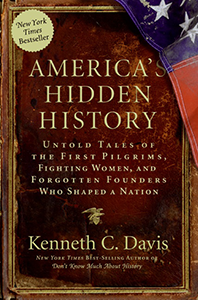
America’s Hidden History, includes tales of “Forgotten Founders”

Don’t Know Much About® History: Anniversary Edition (Harper Perennial and Random House Audio)

Now In paperback THE HIDDEN HISTORY OF AMERICA AT WAR: Untold Tales from Yorktown to Fallujah
June 30, 2016
Whatever Became of 56 Signers (Part 10 of 11)
(Part 10 of a series that begins here. A YES at the end of the entry means the signer owned slaves; NO means he did not.)
…We mutually pledge to each other our Lives, our Fortunes , and our Sacred Honor.
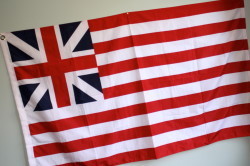
The Grand Flag of the Union, first raised in 1775 and by George Washington in early 1776 in Boston. The Stars and Stripes did not become the “American flag” until June 14, 1777. (Author photo © Kenneth C. Davis)
A victim of the British. Two Irish immigrants. An orphaned carpenter. Among the next five of 56 signers.
–Richard Stockton (New Jersey) Of the signers who clearly suffered for his actions, this successful and widely-admired 45 year old attorney at the signing, may have suffered most. Stockton is also credited with recruiting John Witherspoon, an influential Sottish minister, (See next installment in series) to become president of the College of New Jersey (later Princeton). Betrayed by loyalists in his home state, he was captured by the British in 1776, although later released in a prisoner exchange, not for having sworn allegiance to the King, as reported in a much-disputed rumor of the day. His New Jersey home was also damaged by the British but later restored. Stockton was in poor health after the experience in captivity but lived until 1781, when he died of throat cancer. YES
–Thomas Stone (Maryland) Among the conservatives in Congress, he was a 33 year old attorney at the signing, reluctant about independence, but then joining in the favorable vote. Another son of a wealthy planter, he had a low profile after the signing, helping write the Articles of Confederation but not signing them. He also declined to take part in the Constitutional Convention, when his wife, who fell ill following an inoculation against smallpox, died in 1787. Apparently despondent, he died four months later in 1787 at age 44. YES
–George Taylor (Pennsylvania) Arriving in America as an indentured servant from Ireland, he was a 60 year old merchant and iron maker at the signing. He had risen at the foundry where he worked to become bookkeeper, then bought the business after his employer’s death and then married the late owner’s widow. Taylor was not in the influential Pennsylvania delegation for the July vote, but signed the document in August. During the war, his foundry provided cannon and cannonballs for the war effort, but Congress was notoriously slow to pay its bills and his business suffered. He died in 1781 at age 65. YES
–Matthew Thornton (New Hampshire) An Irish-born physician, he was around 62 at the signing, a veteran surgeon who had served with the New Hampshire militia in the French and Indian War. A latecomer to Congress, he joined in November 1776 and was later permitted to add his name to the document. He later served as a state judge and then operated a farm and ferry before his death in 1803 at about age 89. NO
–George Walton (Georgia) Orphaned and apprenticed as a carpenter, he was a 35 year old self taught attorney at the signing. Serving with the Georgia militia, he was shot and captured by the British in 1778. Well-treated, he was held for a year before being exchanged for a British officer –even though it was known he was a signer. He later served in a variety of state offices, including governor and senator from Georgia, and built a home on lands confiscated after the war from a Tory, or Loyalist. He is implicated in the events that led to the duel that killed fellow signer and political rival Button Gwinnet (see Part 3 of series). He died in 1804, aged 63. NO? [Unable to confirm his status as slaveholder pending further investigation.]

Don’t Know Much About® the American Presidents (Hyperion Paperback-April 15, 2014)

Don’t Know Much About® History: Anniversary Edition (Harper Perennial and Random House Audio)
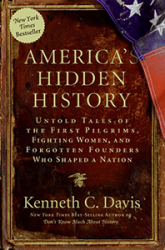
America’s Hidden History, includes tales of “Forgotten Founders”
June 29, 2016
Whatever Became of 56 Signers? (Part 9)
(Part 9 in a series that begins here; a YES following the entry means the signer owned slaves; NO means he did not own slaves.)
…We mutually pledge to each other our Lives, our Fortunes , and our Sacred Honor.

The Grand Flag of the Union, first raised in 1775 and by George Washington in early 1776 in Boston. The Stars and Stripes did not become the “American flag” until June 14, 1777. (Author photo © Kenneth C. Davis)
Betsy Ross’s uncle. The “first psychiatrist.” Youngest signer. The Great Compromiser. An Irish man named Smith. The next five signers:
–George Ross (Pennsylvania) The son of a Scottish-born minister, he was a 46 year old attorney at the signing, a loyalist before turning to the patriot cause in 1775. Yes, he was Betsy’s uncle, but the rest of the Ross flag story has been dismissed as family legend. He left Congress in early 1777 due to illness — the same severe gout that afflicted a number of signers– and served as a Pennsylvania judge before his death in 1779 at 49, following a severe attack of gout. NO
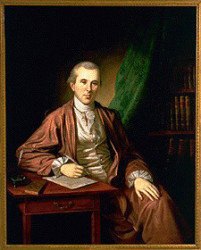
Dr Benjamin Rush by Charles Willson Peale c. 1783. Winterthur Museum
–Benjamin Rush (Pennsylvania) Raised by a widowed mother, he was a 30 year old physician at the signing, youngest in the Pennsylvania delegation. He was elected after the July vote and his diaries, letters and notes provided some of the best portraits of many of the signers and other founders. He served as surgeon general of the armies during the war, and became an early abolitionist while still owning a slave himself. Rush was an early advocate of many modern medical practices, while at the same time practicing bloodletting. He established the first free medical clinic and remained in Philadelphia during a yellow fever epidemic, spoke against capital punishment and for the idea that there was mental illness which led to his being called “The Father of American Psychiatry.” He died of typhus in 1813 at age 67. YES
–Edward Rutledge (South Carolina) Son of an Irish immigrant physician, he was a 26 year old attorney at the signing, the youngest of the signers. Rutledge later left Congress and was captured by the British when Charleston fell in May 1780 and was held for nearly a year. After the war, his finances and businesses flourished and he returned to state politics, and was elected governor of South Carolina, but died at 50 in 1800, before his term ended. YES
–Roger Sherman (Connecticut) A self-educated son of a farmer, he was a prosperous merchant, attorney and politician, aged 55 at the signing. He would sign three of the central documents in America’s foundation: the Declaration (he was a member of the draft committee), the Articles of Confederation, and the U.S. Constitution. It was at the 1787 convention that Sherman proposed the “Great Compromise” that ended the deadlock between large and small states. He was also a true “Founding Father”–after Carroll (18 children) and Ellery (16 children), Sherman fathered the third most children among the signers -15. A leading Federalist, he served in the House and Senate, where he was serving at his death in 1793 at age 72. NO
–James Smith (Pennsylvania) Another immigrant signer, he was born in Ireland and was around 57 at the signing, another self-taught attorney. Elected to Congress after the July vote, he signed the Declaration. He returned to law practice and state offices before his death in 1806 at about age 87. NO

Now In paperback THE HIDDEN HISTORY OF AMERICA AT WAR: Untold Tales from Yorktown to Fallujah

Don’t Know Much About® History: Anniversary Edition

America’s Hidden History, includes tales of “Forgotten Founders”
June 28, 2016
COMING IN SEPTEMBER 2016: “In the Shadow of Liberty”
The first prepublication reviews are in for In the Shadow of Liberty: The Hidden History of Slavery. Four Presidents, and Five Black Lives. (Holt Books for Young Readers/Penguin Random House Audio, September 20, 2016)

In the Shadow of Liberty: The Hidden History of Slavery, Four Presidents, and Five Black Lives (Holt Books & Random House Penguin Audio-Sept. 2016)
In a *Starred Review, Booklist said,
“A valuable, broad perspective on slavery, paired with close-up views of individuals who benefited from it and those who endured it.” Booklist
And Kirkus has just called the book,
“An important and timely corrective.” Kirkus
In the Shadow of Liberty will be published by Holt Books for Young Readers on Sept. 20, 2016.
Whatever Became of 56 Signers? (Part 8)
[Part 8 of a series that begins here; Note: YES following an entry means the signer owned slaves; NO means he didi not.]
…We mutually pledge to each other our Lives, our Fortunes , and our Sacred Honor.

The Grand Flag of the Union, first raised in 1775 and by George Washington in early 1776 in Boston. The Stars and Stripes did not become the “American flag” until June 14, 1777. (Author photo © Kenneth C. Davis)
Minister turned lawyer. Self-taught planters’s sons. A Nay vote. A rare bachelor. And a veiled man. The next six signers:
–Thomas Nelson, Jr. (Virginia) Another son of a wealthy planter. he was a 37 year old merchant-planter at the signing, owner of more than 400 enslaved people. He raised money to supply troops and even commanded militia. Legend has it that he fired a cannon at his own Yorktown mansion during the 1781 siege when told that it was British headquarters. The war cost him financially and he was in ill health, retiring as Virginia’s governor and living on his plantation until his death at 50 in 1789. YES
–William Paca (Maryland) An attorney and wealthy planter’s son, he was 35 at the signing. A patriot leader in somewhat conservative Maryland, he helped bring the state to favor independence at Philadelphia. He raised funds for the war effort and later, as Congressman, worked to support veterans. An advocate of the Constitution, he was later appointed a federal judge by President Washington, and was in that post at his death in 1799 at age 58. YES

Robert Treat Paine (Courtesy: Massachusetts Historical Society, Boston, Massachusetts)
–Robert Treat Paine (Massachusetts) Overshadowed by two Adamses and Hancock from Massachusetts, he was a minister turned attorney, 45 at the signing, best known as one of the prosecutors in the 1770 trial of the British soldiers charged in “Boston Massacre.” His friend and fellow delegate John Adams had served rather successfully as their defender. In 1780, he was among the founders of the American Academy of Arts and Sciences, one of the first American groups dedicated to expanding scientific knowledge and learning. After the war, he remained active in Massachusetts politics and was named a state judge by Hancock until his retirement in 1804 due to deafness. He died in 1814 at age 83. NO
–John Penn (North Carolina) A wealthy planter’s son who taught himself to read and write, he was a 36 year old attorney at the signing. He remained in Congress and was one of the signers who also signed the first American constitution, the Articles of Confederation. He retired to private law practice and died in 1788 at age 48. YES
–George Read ( Delaware) Among the conservative delegates, he was a 42 year old lawyer at the time of the signing but had voted against independence on July 2.He served in state offices until ill health forced his resignation. But he returned to Philadelphia to take part in the Constitutional convention and was leading voice for small states’s rights and led the ratification forces in Delaware, the first state to ratify the Constitution. Elected to the Senate, he resigned to take a judgeship in Delaware before his death in 1798 at age 65. YES
–Caesar Rodney (Delaware) Another self educated attorney, son of a planter, he was 47 at the signing. He is best known for an 80 mile ride in a storm to break a deadlock that put Delaware in the independence column –which cost him favor with conservatives in his home state. One of the three bachelor signers (Francis Lee and Thomas Lynch were the others), he remained in the Congress until he became Delaware’s state president. A cancerous growth on his face was untreated and he covered it with a silk veil, worn for a decade before his death in 1784 at age 55. YES

Don’t Know Much About® the American Presidents (Hyperion Paperback-April 15, 2014)

Don’t Know Much About® History: Anniversary Edition (Harper Perennial and Random House Audio)




